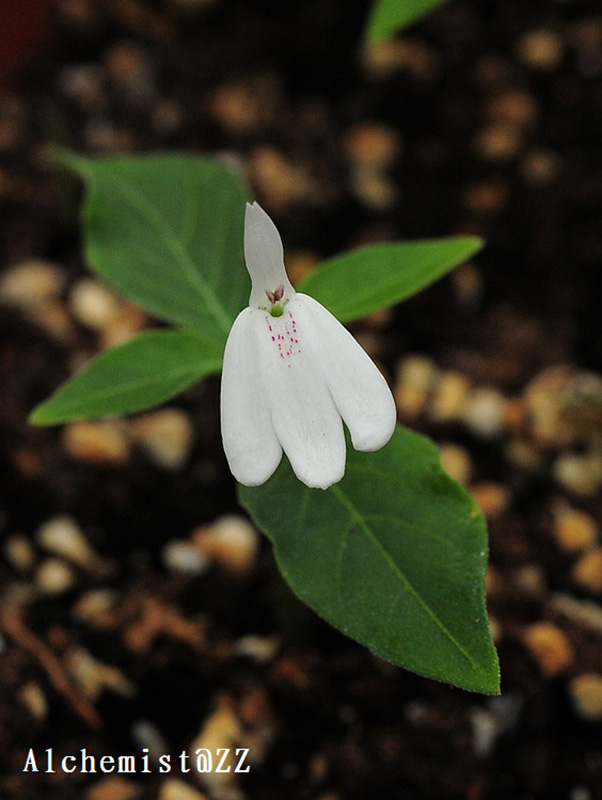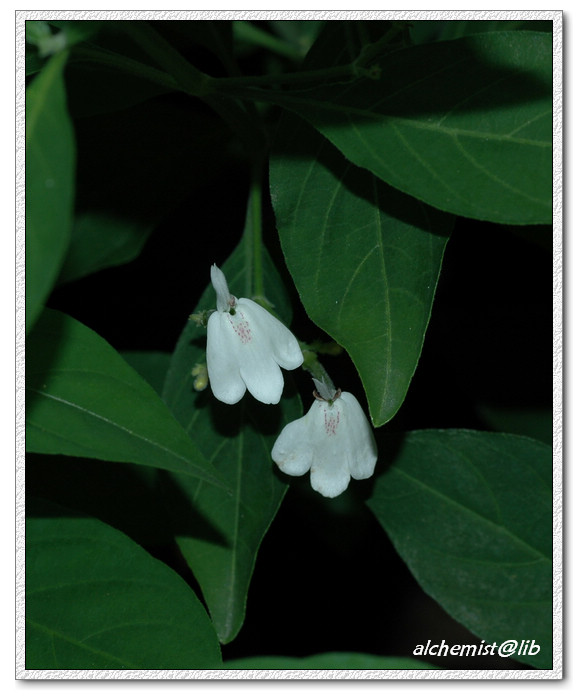灵枝草 Rhinacanthus nasutus

- Scientific Name: Rhinacanthus nasutus (L.) Kurz
- Ref: J. Asiat. Soc. Bengal, Pt. 2, Nat. Hist. 39:79. 1870
- Synonyms: Justicia nasuta L., Rhinacanthus macilentus C.Presl, R. osmospermus Bojer ex Nees, R. rottlerianus Nees
- English Common Name: snake jasmine, ringworm root
- Chinese Common Name: 白鹤灵枝/白鹤灵芝 báihè língzhī, 灵枝草/灵芝草 língzhīcǎo
- Japanese Common Name: リナカンサス rinakansasu, ハッカクレイシソウ [白鶴霊芝草] hakkakureishisō
- Family: Acanthaceae
- Genus: Rhinacanthus
- Distribution: Thickets, forests, cultivated around villages; below 700 m. Guangdong, Hainan, Yunnan [Cambodia, India, Indonesia, Laos, Malaysia, Myanmar, Philippines, Sri Lanka, Thailand, Vietnam; Madagascar].
- Photo: 04/19/2013, Chenshan Botanical Garden, Shanghai
Subshrubs or perennial herbs, to 1.5 m tall. Stems stout, ± 4-angled, faintly striate, densely pubescent when young then glabrescent. Petiole 0.5-1.5 cm; leaf blade elliptic, ovate-elliptic, or rarely lanceolate, 2-7(-11) × 0.8-3 cm, abaxially densely pubescent, adaxially sparsely pubescent to subglabrous, secondary veins 5 or 6 on each side of midvein, base cuneate, margin entire or slightly undulate, apex shortly acuminate to acute. Panicles terminal or axillary, to 50 cm; rachis densely pubescent; bracts lanceolate, to 2 × 0.5 mm; bracteoles ca. 1 mm. Flowers sessile to subsessile. Calyx ca. 5 mm, both surfaces pubescent; lobes lanceolate, ca. 4 × 0.7 mm. Corolla greenish white, 2.1-2.7 cm, outside pubescent with gland-tipped and non-glandular trichomes; tube 1.5-1.8 cm; lower lip 0.75-1.2 cm, lobes 2-4 mm and subequal; upper lip linear-lanceolate, 6-7.5 mm, erect. Staminal filaments glabrous. Style sparsely pubescent. Capsule ca. 2 × 0.3 cm, pubescent with gland-tipped trichomes. Seeds ca. 2.5 × 2.2 mm, papillose. Fl. Oct-Dec. 2n = 30. (Flora of China)

06/18/2009, Xiamen, Fujian